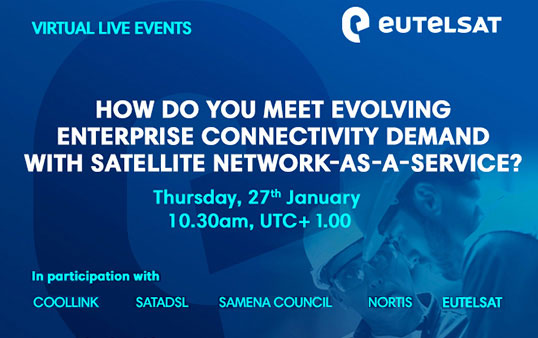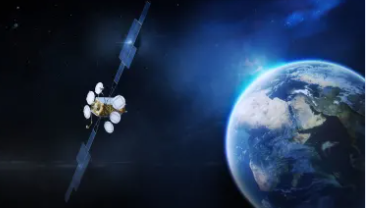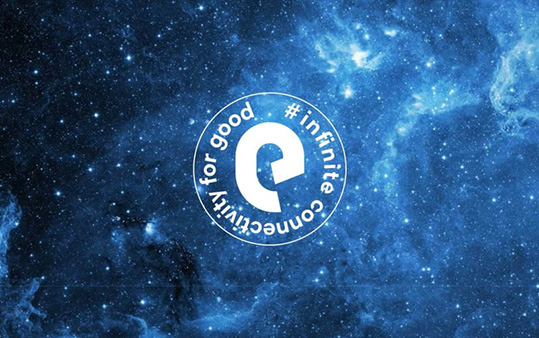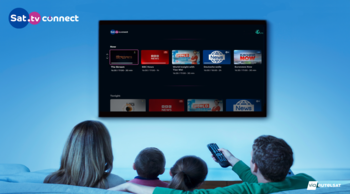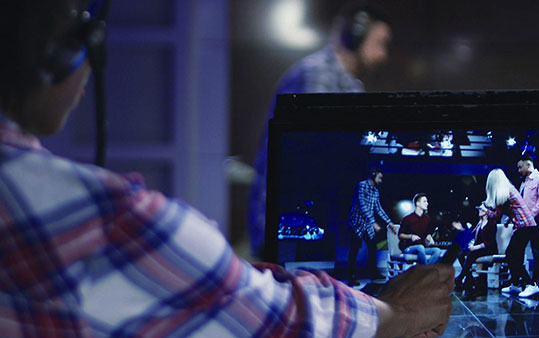FEEDING DTT, CABLE & IP HEAD-ENDS
Satellites are the most efficient platform for delivering channel multiplexes to cable and IPTV head-ends, Digital Terrestrial transmitters, as well as directly serving homes which remain beyond the range of DTT reception.
With proven experience of DTT broadcasting in France, Greece, Italy and Ireland in Europe, and in Africa, in Algeria, Equatorial Guinea, Gabon, Kenya and Zimbabwe, among many others, you can rely on our experience and expertise to deliver on your promises.
Eutelsat's end-to-end turnkey solution includes satellite and ground segment, providing you with powerful regional coverage, flexibility and scalability.
Alongside our technical expertise we can help you break into the DTT market with Eutelsat's marketing team and take advantage of extensive TV market knowledge in Europe, North Africa and the Middle East.
FREE-TO-AIR DISTRIBUTION
Designed for growing broadcasters and multimedia content providers, Eutelsat Digital Platforms (EDPs) are the answer for cost-effective access to satellite networks and turnkey services.
EDPs give broadcasters immediate reach to the wide audiences available via satellite, without the need to invest in expensive multiplexing facilities.
In addition to satellite bandwidth, the turnkey service includes channel collection from your premises, multiplexing of the content and uplinking to the satellite, giving you cost-effective access to large established audiences.
We offer full turnkey services including turnaround, encryption, hosting, and 24/7 monitoring and control.
Our flexible bitrate options can handle all types of transmissions from audio and cartoons to action-packed sports coverage.
Join the fastest growing hotspot for the region with over 4 million TV homes at 7° East
Reach over 4 million homes from 16° East, Africa's leading free-to-air neighbourhood
Join the channels broadcasting to TV homes in Central Africa from 3° East
Benefit from the high power coverage at 8° West to reach TV homes across the region
Deliver your content to 160M homes at EMEA's leading HOTBIRD neighbourhood
Broadcast your channel into Brazil directly from North America and Europe
MAXIMISING REACH FOR FTA CHANNELS

Eutelsat has revolutionised the free-to-air (FTA) TV experience with Sat.tv, a new generation of satellite receivers including an enriched electronic programme guide (EPG) and TV bouquets.
With its local-first philosophy and easy-to-use navigation, Sat.tv enables greater channel discovery, for the benefit of broadcasters and audiences alike.
Channels are referenced in low-cost, mass market FTA set-top boxes, with prominent channel numbering for each relevant market, comprehensive programme information, and content discovery functionalities, maximising the conversion of massive satellite reach into real TV audience.
Sat.tv is available at Eutelsat’s 7/8° West and HOTBIRD 13° East orbital positions, the leading TV neighbourhoods for Europe, the Middle East and North Africa, reaching over 120 million DTH homes, and being progressively deployed at other Eutelsat video neighbourhoods. The service is also being extended to new generations of connected televisions (with integrated satellite tuner) with the new interactive application, "Sat.tv Connect".
7 Day+ programme guide instantly displayed on TV screens
The EPG gives viewers visibility to the entire channel line-up, with a preview of all programmes to be aired, including programme thumbnails in several languages – a first for the FTA market.
Automatic installation and up-to-date channel list per country
All channels are automatically installed on the satellite receivers, with a fixed channel numbering. As receivers are updated automatically overnight, new channels can be accessed by viewers immediately, with no complex reinstallation or re-scanning to be done by the end-user.
Enhanced channel recognition with logos
An easy-to-use, graphic-based navigation presents viewers with the channel name, logo, and channel genre, written in the local language (including Arabic script). Referenced with a single channel number, they can be discovered by filtering on a specific channel theme. This makes relevant channels easier to find by audiences who are interested in specific genres.
Increased ad revenues through regional channel referencing
National broadcasters can be found more easily by their target audience. Broadcasters can also drive different audiences to different video feeds and customise advertising to specific audiences. By combining the massive audience of satellite broadcast, with targeted engagement, Sat.tv helps boost advertising revenues.
Strengthening your linear TV audience
Sat.tv improves your end-user experience, attracting more viewers to a channel's content, which means more value for advertisers and more revenue for the channel.
Available on a new generation of free satellite receivers
Sat.tv runs on low-cost set-top boxes and is being rapidly implemented by a wide range of set-top box manufacturers. It is free-of-charge for set-top box vendors, as well as for broadcasters operating at Eutelsat’s video hotspots.
SATELLITE MULTISCREEN
Satellite Multiscreen increases a broadcaster’s reach to mobile screens in areas where internet is not sufficient. Content multicast over satellite can be watched on IP devices, irrespective of the quality of the internet connection, enabling broadcasters to distribute content to all screens and regions, no matter how remote their audience.
As we increasingly use our mobile devices to access video content and stream live events, we want to enjoy the same content experience we have at home, wherever we are. However, at public venues visitors often cannot reliably stream video content on their mobile devices without suffering buffering issues when demand is high.
By leveraging the power of satellite broadcasting, broadcasters and public venue owners can address this untapped audience and provide a high-quality, cost-effective viewing experience for visitors. They can deliver high quality video streaming services to mobile devices, irrespective of local internet connection speeds or network congestion.
Combining Eutelsat’s extensive satellite fleet with local Wi-Fi distribution, linear TV and video distribution to mobile devices has never been more reliable or better quality, even in areas where there is limited terrestrial coverage - no matter how many simultaneous viewers, and without consuming any mobile data allowance.
Thanks to the inherent strength of linear multicast over satellite, the superior quality of video distribution extends access to video content on mobile devices beyond terrestrial networks, and helps broadcasters maximize both reach and content monetization.
BROCHURE
USE CASE - NEXT-GEN. DTH
Offering a multi-screen, multi-room experience on any device, providing top-tier quality for live and offline video reception, personalized content, superior user interfaces, and comprehensive analytics - these are all part of the challenge broadcasters face when delivering content to their end-users.
Today, two new industry standards developed through a collaborative initiative of the broadcast community are enabling broadcasters to do just that, with DVB-Native IP for next-generation broadcast delivery; and DVB-I for unified and simplified content discovery and delivery of rich content guide metadata.
USE CASE - HOSPITALITY
In the hospitality industry, when guests want to watch popular content, particularly live sports, it can have an enormous impact on the venue’s connectivity service. For venues in poorly connected areas, latency issues, limited bandwidth and lack of affordable data packages are all part of the challenge for broadcasters and media providers needing to deliver quality video content to their audiences on any device.
New content delivery solutions based on the DVB-Native IP standard, combine satellite in the delivery mix, enabling hotels in poorly connected areas to receive OTT content without relying on the internet. Delivering an optimum viewing experience to all guests, it supports large-scale content distribution, offering the multi-screen experiences guests expect.
USE CASE - EDUCATION
ED4free is a non-profit association specialising in inexpensive, easy-to-use educational technology for developing countries. They’ve created the EDBox, an economical off-line content server pre-loaded with resources for schools and training programmes. However, as the EDBoxes are often located in areas where there is no internet connectivity, updating the servers is problematic.
To resolve this, ED4free is partnering with Eutelsat, ENENSYS, and EKT to revolutionize the delivery of educational content. By leveraging cutting-edge, standardized, broadcast technology, they aim to reach a wider audience bringing multimedia education to regions where internet connectivity is not available. Read our whitepaper to find out how DVB-NIP can empower students.
We provide broadcasters and news programmers with contribution links for original, post-produced and fully contributed news, sports and entertainment segments for finished programme integration.
Whatever your signal type, whether it’s for DTH broadcasting, DTT rebroadcasting, radio or data, our contribution services ensure signals reach the right uplink station or multiplexing platform for point-to-point or point-to-multipoint transmissions.
We also offer a cost-effective service for contribution links to digital TV platforms on Eutelsat satellites and in particular for Eutelsat’s Digital Platforms. By minimising the overall costs of digital platform services, we make platform access attractive to smaller broadcasters.
GROUND SUPPORT
To ensure high-quality video distribution, four primary elements must all be in place before a channel can focus on creating quality content: hosting, service quality, resilience and recovery.
Eutelsat operates a full range of ground services for cost-effective access to our satellite fleet, to ensure channels deliver the highest standards of quality to audiences.
Hosting
Host your servers in our fully redundant infrastructure, and maintain control of your applications, with dedicated server racks in secure, co-located or private rooms.
Premium Service Level Agreement
At Eutelsat, we commit to clear and measurable targets in our Premium Service Level Agreements to help you manage your business-critical operations and avoid dissatisfied customers or revenue loss.
Satellite Interference Mitigation
Interference can be a major problem for service reliability. At Eutelsat you can expect our best resources to keep your service operational, even if there’s interference from external factors, or severe weather conditions.
Ground Disaster Recovery
In the case of critical disasters, faulty equipment or serious damage, customers can safeguard their networks and guarantee 24/7 broadcast operations with a disaster recovery plan.
